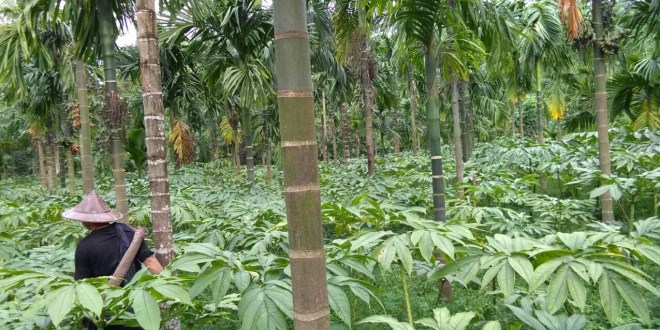The local farmers in Ye Township, Mon State face difficulties on their elephant foot yam plantations due to little technical support.
Local people in the south of Ye Township rely on farming the elephant foot yam (or Amorphophallus paeoniifolius ) for subsistence income. There is market demand for the yams and the prices have increased yearly. However, farmers need technical support for Yam cultivation. According to U Tin Thein, the head of the Elephant Foot Yam Cultivation Support Association in Ye Township, respective government departments should provide the same educational support that they provide for rubber, rice and other crop cultivation sectors.
“Yam farming is getting bigger and bigger compared to the past. The Chinese business people come to buy yams from the villages. The Japanese factory in Ye Township is also buying the yams. The farmers can get better prices and claim that they will grow the yams in coming years. Lots of locals are growing the yams now. Here, we have lots of land to grow on but need investment to address technical problems. The yams grow naturally in the wild, but now they can also be grown on farms. Now, locals can grow yams not only for subsistence but also business. So, I want to say that the state government should provide for that,” said U Tin Thein.

In particular, farmers need assistance dealing with plant disease. Typically, the yams are planted in April or May, and it takes 6 months until they are ready to be harvested, usually around September or October.
“In the rainy season, the tubers are affected more by pests. The pests eat the leaves and this causes the plant color to change. The plant will become yellow and decayed. This disease will then be transmitted to other plants. We need educational support for this problem, so we can grow more,” said U Naing, Administrator of HangGang Village in Ye Township and grower of elephant foot yams.
There is great business potential in the elephant foot yam industry if farmers receive quality technical training. In Ye Township, the [wet] elephant foot yam price was 600 Kyat per peittha [1 peittha equals 1.63293 Kg] in 2016, around 1,500 Kyat per peittha in 2017, and 2,000 Kyat per peittha in 2018. The dried yam price is higher, selling for 12,000 Kyat per peittha in 2018.
One elephant foot yam plant can produce one peittha. Around 5,000 plants can be grown on one acre of land. With the market price at 2,000 Kyat per yam, it is estimated that farmers can earn up to 10 million Kyat per acre.
The yams from Ye Township have become in demand by the Chinese business people, and from there, the yams are transported to Mandalay for the domestic market.
In Ye Township, there are 40 farmers growing the yams, and each farmer can grow yams on approximately 2 acres of land. The farms are located in the south of Ye Township, primarily in YinDein, Kabyar and SinGuu villages.
The elephant foot yams serve a variety of purposes. Once grinded into powder, the yam tubers are used for medical purposes, snacks, and pet food. They can be found in noodles, fake-meat goods, and food for people working in offshore oil rigs. They can also be used in stationary appliances and screen printing.
The elephant foot yams naturally grow in abundance in Mon, Karen, Shan, Kachin, and Chin states, and Mandalay, Bago, Sagaing, and Ayeyarwady regions. Today, farmers are becoming more interested in cultivating the yams, since the demand from China and Japan is creating more business potential.

